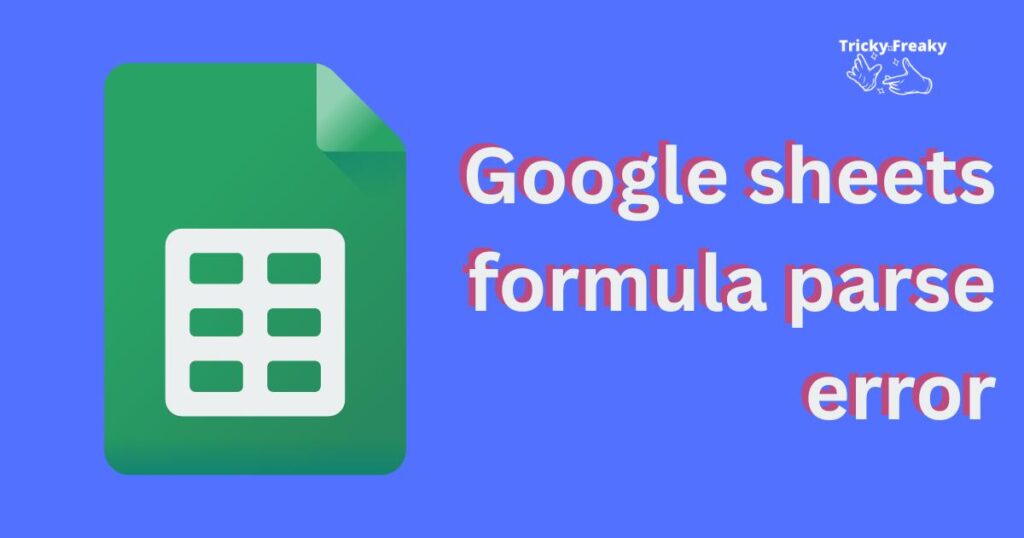Google Sheets is a useful asset that permits clients to successfully oversee and break down information. With its great many equations and capabilities, it empowers clients to perform complex estimations and computerize assignments easily. Nonetheless, similar to any product application, Google Sheets isn’t safe to mistakes. Quite possibly the most widely recognized blunder clients experience is the “Recipe Parse Mistake.”
Understanding the reasons for equation parse mistakes is pivotal for productive information the executives and investigating. In this article, we will dive into the explanations for recipe parse blunders in Google Sheets and give reasonable answers for assist you with beating them. By acquiring a more profound comprehension of this blunder, you will be prepared to deal with equation-related issues really and boost the capability of Google Sheets as an information examination instrument.

Causes of the error
- Linguistic structure Blunders: Recipe parse mistakes frequently happen because of punctuation mistakes, which include inaccurate utilization of equation parts. Normal sentence structure mistakes incorporate incorrectly spelled capability names, absent or befuddled brackets, ill-advised utilization of administrators, or erroneous position of commas inside capability contentions.
- Deficient Equations: Fragmented recipes lacking required contentions or boundaries can result in parse mistakes. Guarantee that every single vital part, for example, cell references and works, are appropriately remembered for the recipe.
- Invalid Cell References: In the event that an equation alludes to a cell that has been erased, moved, or contains contrary information types, Google Sheets will not be able to handle the recipe accurately, coming about in a parse mistake.
- Roundabout References: Roundabout references happen when an equation alludes to its own cell or makes a circle with different cells. Google Sheets can’t determine round references, prompting parse blunders.
- Nonexistent Capabilities: Utilizing nonexistent or incorrectly spelled capability names in your equations will set off a parse blunder.
- Ill-advised Utilization of Quotes: Quotes are utilized in equations to mean text strings or determine ranges. Neglecting to incorporate or inappropriately setting quotes inside a recipe can result in a parse mistake.
- Division by Nothing: Endeavoring to partition a worth by zero in an equation will cause a parse blunder. Really take a look at your recipes to guarantee you are not isolating any qualities by nothing, and consider adding an IF proclamation to deal with likely zero denominators.
- Secret Characters or Spaces: Now and then, covered-up characters or additional areas can be incidentally included inside a recipe. These concealed characters can disturb the recipe’s linguistic structure and result in a parse mistake.
- Information Type Incongruence: Blending incongruent information types, for example, attempting to perform numerical procedure on text values, can prompt equation parse mistakes.
- Equation Length Surpassing Cutoff: Google Sheets has a breaking point on the length of recipes, and surpassing this cutoff can cause parse mistakes. On the off chance that your recipe is unreasonably lengthy or complex, consider separating it into more modest, reasonable parts or utilizing assistant cells to improve on the equation structure.
Solutions for this error
Check Grammar and Capability Names:
Cautiously survey the equation for any grammar blunders. Pay special attention to normal slip-ups like incorrectly spelled capability names, absent or confounded enclosures, ill-advised utilization of administrators, or erroneous arrangement of commas inside capability contentions. Guarantee that every part of the recipe is precisely composed by Google Sheets’ grammar rules.
Confirm Cell References:
Twofold check that the cell references utilized in the recipe are legitimate and exist in the right areas. On the off chance that a referred to cell has been erased, moved, or contains contradictory information types, it can result in a parse mistake. Ensure that the cell references precisely mirror the planned reach or cell address.
Distinguish and Determine Round References:
Assuming you have equations that allude to their own cell or make a circle with different cells, it prompts round references and parse blunders. Recognize any round references in your worksheet and adjust the equations likewise to eliminate the round reliance. You might have to rebuild the equation rationale or utilize iterative computations if pertinent.
Check for Nonexistent Capabilities:
Guarantee that you are utilizing right and existing capability names in your recipes. Google Sheets gives different capabilities, and utilizing nonexistent or incorrectly spelled capability names will set off a parse mistake. Twofold check the capability names, counsel the Google Sheets documentation if necessary, and make the fundamental adjustments.
Read more: Ticketmaster error code u533
Check Quotes Use:
Quotes are utilized in equations to signify text strings or determine ranges. Ill-advised use or exclusion of quotes can prompt parse blunders. Make sure that quotes are accurately positioned and adjusted inside your equations. Make sure to utilize twofold quotes for text strings and single quotes for indicating ranges.
Handle Division by Nothing:
Parsing blunders happen while endeavoring to isolate a worth by zero in a recipe. To stay away from this blunder, guarantee that you’re not isolating any qualities by nothing. You can utilize an IF explanation to check for zero denominators and give elective computations or blunders taking care of forestall division by nothing.
Eliminate Stowed away Characters or Spaces:
In some cases, stowed-away characters or additional areas can unintentionally be incorporated inside a recipe. These secret characters or spaces can disturb the equation’s grammar and result in a parse mistake. Cautiously survey the equation and eliminate any pointless spaces or secret characters that might have been incidentally added.
Improve on Complex Recipes:
In the event that your equation is unreasonably lengthy or complex, it might surpass the recipe length limit in Google Sheets, coming about in a parse mistake. Consider improving on the recipe by separating it into more modest, sensible parts. You can utilize assistant cells to store middle-of-the-road results and work on the general recipe structure. On the other hand, you may likewise think about utilizing custom capabilities or contents to deal with complex estimations past the capacities of standard equations.
Conclusion
Equation parse mistakes can be baffling while working with Google Sheets, however with an unmistakable comprehension of their causes and reasonable arrangements, you can really conquer them. By checking linguistic structure, confirming cell references, and resolving issues, for example, roundabout references and nonexistent capabilities, you can fundamentally lessen the event of parse mistakes.
With each experience of a recipe parse blunder, move toward it as a potential chance to learn and upgrade how you might interpret Google Sheets’ capacities. With training and commonality, you will turn out to be more adroit at distinguishing and settling equation parse blunders, making your involvement in Google Sheets much more useful.
All in all, outfitted with the information and arrangements introduced in this article, you are better prepared to explore the universe of Google Sheets and conquer recipe parse mistakes, empowering you to bridle the maximum capacity of this useful asset for coordinating, breaking down, and deciphering information really.
FAQs
This irregularity might happen in the event that the recipe depends on outer elements, like the accessibility of specific information or the presence of explicit cells. In the event that these elements change or are not met, it can result in a parse blunder. Guarantee that all conditions are set up for the equation to reliably work.
Indeed, contingent organizing can at times impede recipes, prompting parse blunders. On the off chance that your recipes reference cells impacted by restrictive organizing rules, it might cause clashes. Consider changing your contingent arranging rules or rethinking the recipe rationale to keep away from such struggles.
At the point when you reorder an equation, it holds the first cell references. On the off chance that these references don’t appear to be legit in the new area, it can prompt parse mistakes. Confirm and refresh the cell references in the wake of gluing the recipe to guarantee they line up with the expected reach.
Inconsistent parse blunders can be trying to investigate. Begin by evaluating the recipe for any irregularities, check for any outer variables that might influence the equation’s usefulness, and examine the information in question. Consider utilizing contingent explanations or blunder dealing with capabilities like IFERROR to deal with possible irregularities and give substitute estimations or mistake messages.
